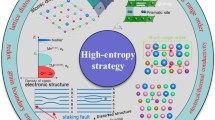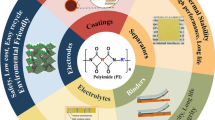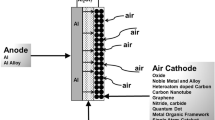Abstract
Context
Energetic materials are a class of materials containing explosive groups or containing oxidants and combustibles. The optimization of energetic materials has a significant impact on the development of industry and national defense. For high-energy density compounds (HEDC) that have not been synthesized or are dangerous to experimental operation, it is of guiding significance to predict its energy level, physicochemical properties, and safety through molecular design and theoretical calculation. Cyclic urea nitramine series compounds are a type of energetic compounds with high density and excellent detonation performance. In this study, 2,5,7,9-tetranitro-2,5,7,9-tetraazabicyclo[4,3,0]nonane-8-one (K-56) was used as the parent structure, and 36 energetic derivatives were designed. The effects of introducing single and multiple substituents on the electronic structure, energy gap, heat of formation, detonation performance, thermal stability, thermodynamic parameters, and surface electrostatic potential of K-56 and its derivatives were discussed in detail. The results exhibit the following: (1) the single substitution of -C(NO2)3 (A6) can reduce the detonation velocity of K-56 by 11.9 % and the detonation pressure by 19.8 %, while the double substitution of -C(NO2)3 (B6) can increase the density of K-56 by 11.6 %, the detonation velocity by 10.9 %, and the detonation pressure by 31 %. (2) The heat of formation of K-56 (−110.0 kJ mol−1) increased by 324.18 % and 628.81 %, respectively, proving that -N3 is an extremely effective group to improve HOF. (3) The thermal stability of the derivatives generated by the monosubstitution of the target group on the six-membered ring is better than that of the parent compound.
Methods
Gaussian16 and Multiwfn 3.8 packages are the software for calculation. In this study, the parent structure K-56 and its derivatives were optimized at the B3LYP/6-311G (d,p) level to obtain the zero point energy and thermal correction data of all compounds. Then the vibration analysis of the optimized structure is carried out to confirm that its configuration is stable. Then the M06-2X-D3/def2-TZVPP basis set is used to calculate the single point energy.















Similar content being viewed by others
Data availability
We confirm the availability of all the data and materials in this manuscript. The manuscript has full control of all primary data, and the authors agree to allow the journal to review their data if requested.
Code availability
N/A.
References
Madhukar AB, Mahadev T, Zarko VE, Pramod M (2019) Recent advances in safe synthesis of energetic materials: an overview. Combust Explos Shock Waves 55:245–257. https://doi.org/10.1134/S0010508219030018
Venugopal T, Haixiang G, Jean’ne MS (2011) Trinitromethyl-substituted 5-nitro- or 3-azo-1,2,4-triazoles: synthesis, characterization, and energetic properties. J Am Chem Soc 133:6464–6471. https://doi.org/10.1021/ja2013455
Renfa Z,Xiaosong X, Peng M, Congming M, Diandian Z, Yong P, Juncheng J (2022) High-energy materials based on 1H-tetrazole and furoxan: molecular design and screening. J Mol Struct 1250: 131900. https://doi.org/10.1016/J.MOLSTRUC.2021.131900
Lina H, Xuqin L, Congming M, Peng M, Yong P, Juncheng J (2022) Thermodynamic properties, decomposition kinetics of 2-(5-amino-2H-tetrazol-1-yl)-4-amine-3,5-dinitropyridine. J Mol Model 28:79. https://doi.org/10.1007/s00894-022-05066-2
Wenxin X, Renfa Z, Xiaosong X, Congming M, Peng M, Yong P, Juncheng J (2021) Theoretical studies of novel high energy density materials based on oxadiazoles. J Mol Model 27:204. https://doi.org/10.1007/s00894-021-04805-1
Qiong W, Linghua T, Zusheng H (2015) A new design strategy on cage insensitive high explosives: symmetrically replacing carbon atoms by nitrogen atoms followed by the introduction of N-oxides. RSC Adv 5:93607–93614. https://doi.org/10.1039/2046-2069/2011
Qiong W, Weihua Z, Heming X (2014) A new design strategy for high-energy low-sensitivity explosives: combining oxygen balance equal to zero, a combination of nitro and amino groups, and N-oxide in one molecule of 1-amino-5-nitrotetrazole-3N-oxide. J Mater Chem A 2:13006–13015. https://doi.org/10.1039/C4TA01879F
Sikder AK, Sikder N (2004) A review of advanced high performance, insensitive and thermally stable energetic materials emerging for military and space applications. J Hazard Mater 112:1–15. https://doi.org/10.1016/j.jhazmat.2004.04.003
Goede P, Wingborg N, Bergman H (2001) Syntheses and analyses of N,N′-dinitrourea. Propellants Explos Pyrotech 26:17–20. https://doi.org/10.1002/1521-4087(200101)26:13.3.CO;2-R
Il'Yasov SG, Lobanova AA, Popov NI, Sataev RR (2002) Chemistry of urea nitro derivatives: IV. Reaction of N,N′-dinitrourea with formaldehyde. Russ J Org Chem 38:1739–1743. https://doi.org/10.1023/A:1022555327527
Pagoria PF, Lee GS, Mitchell AR, Schmidt RD (2002) A review of energetic materials synthesis. Thermochim Acta 384:187–204. https://doi.org/10.1016/S0040-6031(01)00805-X
Peng M, Yong P, Juncheng J, Shunguan Z (2018) Molecular dynamic simulation and density functional theory insight into the nitrogen rich explosive 1,5-diaminotetrazole(DAT). Procedia Eng 211:546–554. https://doi.org/10.1016/j.proeng.2017.12.047
Boileau J, Emeury J, Kehren J (1974) Tetranitroglycoluril, its manufacture and use as an explosive:DE2435651C3 https://patents.google.com/patent/DE2435651C3/en#patentCitations
Yuye X, Zhengqian C, Naiyan W (1991) Relationships between properties and electronic structure of cyclourea nitro-amine compounds-IV. Study of Thermodecomposition. Chinese. J Anal Chem 19(12):1387–1391
Graindorge HR, Lescrop PA (1995) Synthesis of 2,5,7,9-tetranitro-tetraazabicyclo(4,3,0)nonanone (K56) and derivatives. American Chemical Society, Washington, DC (United States)
Sikder AK, Bhokare GM, Sarwade DB (2001) Synthesis, characterization and thermal behaviour of 2,4,6,8-tetranitro-2,4,6,8-tetraazabicyclo [3.3.1] nonane-3,7-dione (TNPDU) and one of its methylene analogues. Propellants, Explos Pyrotech 26(2):63–68
Gilardi R, Flippen-Anderson JL, George C (1990) Structures of 1,3,5-trinitro-2-oxo-1,3,5-triazacyclohexane (I) and 1,4-dinitro-2,5-dioxo-1,4-diazacyclohexane (II). Acta Crystallogr C Cryst Struct Commun 46:706–708. https://doi.org/10.1107/S0108270189012114
Lina H, Xuqin L, Diandian Z, Lie Q, Congming M, Peng M, Juncheng J (2020) Theoretical studies on the performance of HMX with different energetic groups. ACS Omega 5:29922–29934. https://doi.org/10.1021/acsomega.0c04237
Politzer P, Jane SM (1996) Relationships between dissociation energies and electrostatic potentials of CNO2 bonds: applications to impact sensitivities. J Mol Struct 376:419–424. https://doi.org/10.1016/0022-2860(95)09066-5
Byrd EFC, Rice BM (2006) Improved prediction of heats of formation of energetic materials using quantum mechanical calculations. J Phys Chem A 110:1005–1013. https://doi.org/10.1021/jp0536192
Tian L, Feiwu C (2012) Multiwfn: a multifunctional wavefunction analyzer. J Comput Chem 33:580–592. https://doi.org/10.1002/jcc.22885
Politzer P, Jorge M, Jane SM, Monica CC, Alejandro T (2009) An electrostatic interaction correction for improved crystal density prediction. Mol Phys 107:2095–2101. https://doi.org/10.1080/00268970903156306
Mortimer JK, Mortimer JK (1968) Chemistry of detonations. IV. Evaluation of a simple predictional method for detonation velocities of C–H–N–O explosives. J Chem Phys 48:3685–3692. https://doi.org/10.1063/1.1669671
Betsy MR, Samir S, Owens FJ (2002) Density functional calculations of bond dissociation energies for NO2 scission in some nitroaromatic molecules. J Mol Struct Theochem 583:69–72. https://doi.org/10.1016/S0166-1280(01)00782-5
Xinghui J, Jianhua Z, Bingcheng H (2018) Exploration of high-energy-density materials: computational insight into energetic derivatives based on 1,2,4,5-tetrahydro-1,2,4,5-tetrazine. Chemistryopen 7:780–788. https://doi.org/10.1002/open.201800161
Fangpei Z, Xinlu C, Zijiang L, Qihong L, Jun Z, Zhijiang W (2005) Calculations of bond dissociation energies and dipole moments in energetic materials using density-functional methods. Chinese J Phys 147:658–662. https://doi.org/10.1016/j.jhazmat.2006.07.080
Stephen JB, Barney EG (2003) Bond dissociation energies of organic molecules. Acc Chem Res 36:255–263. https://doi.org/10.1021/ar020230d
Frisch MJ, Trucks GW, Schlegel HB, Scuseria GE, Robb MA, Cheeseman JR, Scalmani G, Barone V, Petersson GA, Nakatsuji H, Li X, Caricato M, Marenich AV, Bloino J, Janesko BG, Gomperts R, Mennucci B, Hratchian HP, Ortiz JV, Izmaylov AF, Sonnenberg JL, Williams-Young D, Ding F, Lipparini F, Egidi F, Goings J, Peng B, Petrone A, Henderson T, Ranasinghe D, Zakrzewski VG, Gao J, Rega N, Zheng G, Liang W, Hada M, Ehara M, Toyota K, Fukuda R, Hasegawa J, Ishida M, Nakajima T, Honda Y, Kitao O, Nakai H, Vreven T, Throssell K, Montgomery JA Jr, Peralta JE, Ogliaro F, Bearpark MJ, Heyd JJ, Brothers EN, Kudin KN, Staroverov VN, Keith TA, Kobayashi R, Normand J, Raghavachari K, Rendell AP, Burant JC, Iyengar SS, Tomasi J, Cossi M, Millam JM, Klene M, Adamo C, Cammi R, Ochterski JW, Martin RL, Morokuma K, Farkas O, Foresman JB, Fox DJ (2016) Gaussian 16 Revision A.03. Gaussian, Inc., Wallingford CT
Badgujar DM, Talawar MB, Zarko VE, Mahulikar PP (2019) Recent advances in safe synthesis of energetic materials: an overview. Combust Explos Shock Waves 55:245–257. https://doi.org/10.1134/S0010508219030018
Haixiang G, Qinghua Z, Jean'ne MS (2020) Fused heterocycle-based energetic materials (2012–2019). J Mater Chem A 8:4193–4216. https://doi.org/10.1039/C9TA12704F
Tao W, Weihua Z, Xiaowen Z, Yufang L, Heming X (2009) Molecular design of 1,2,4,5-tetrazine-based high-energy density materials. J Phys Chem A 113:9404–9412. https://doi.org/10.1021/jp902295v
Huynh MH, Hiskey MA, Pollard CJ, Montoya DP, Hartline EL, Gilardi R (2004) 4,4′,6,6′-Tetra-substituted hydrazo- and azo-1,3,5-triazines. J Energ Mater 22:217–229. https://doi.org/10.1080/07370650490893054
Politzer P, Murray JS (2011) Some perspectives on estimating detonation properties of C-H-N-O compounds. Cent Eur J Energ Mat 8(3):209–220. https://doi.org/10.1007/s00894-015-2748-4
Tian L, Chen F (2013) Bond order analysis based on the Laplacian of electron density in fuzzy overlap space. J Phys Chem A 117(14):3100–3108. https://doi.org/10.1021/jp4010345
Guixiang W, Xuedong G, Yan L, Hongchen D, Xiaojuan X, Heming X (2010) A theoretical investigation on the structures, densities, detonation properties, and pyrolysis mechanism of the nitro derivatives of phenols. Int J Quantum Chem 110(9):1691–1701. https://doi.org/10.1016/j.jhazmat.2009.12.088
Cornelia CU, Marcel H, Burkhard K, Thomas MK (2020) Oxygen-rich bis(trinitroethyl esters): suitable oxidizers as potential ammonium perchlorate replacements. Energy Fuels 34:16469–16475. https://doi.org/10.1021/acs.energyfuels.0c02910
Kamlet MJ, Adolph HG (1979) The relationship of impact sensitivity with structure of organic high explosives II. Polynitroaromatic explosives. Propell Explos 4(2):30–34. https://doi.org/10.1002/prep.19790040204
Kohno Y, Maekawa K, Tsuchioka T, Hashizume T (1994) A relationship between the impact sensitivity and the electronic structures for the unique N-N bond in the HMX polymorphs. Combust Flame 96(4):343–350. https://doi.org/10.1016/0010-2180(94)90103-1
Murray Jane S, Lane P, Politzer P (1998) Effects of strongly electron-attracting components on molecular surface electrostatic potentials: applications to predicting impact sensitivities of energetic molecules. Mol Phys 93(2):187–194. https://doi.org/10.1080/002689798169203
Anders G, Borges Jr I (2011) Topological analysis of the molecular charge density and impact sensitivity: models of energetic materials. J Phys Chem A 115(32):9055–9068. https://doi.org/10.1021/jp204562d
Shuji Y, Koshi M (2006) Theoretical studies of energy transfer rates of secondary explosives. J Phys Chem B 110(37):18515–18520. https://doi.org/10.1021/jp062815l
Politzer P, Murray Jane S (2021) Are HOMO–LUMO gaps reliable indicators of explosive impact sensitivity? J Mol Model 27:327. https://doi.org/10.1007/s00894-021-04956-1
Zhaobian X, Shuangqi H, Xiong C (2016) Theoretical insight into the influence of molecular ratio on the binding energy and mechanical property of HMX/2-picoline- N -oxide cocrystal, cooperativity effect and surface electrostatic potential. Mol Phys 114:2164–2176. https://doi.org/10.1080/00268976.2016.1190038
Betsy MR, Jennifer JH (2002) A quantum mechanical investigation of the relation between impact sensitivity and the charge distribution in energetic molecules. J Phys Chem A 106:1770–1783
Murray Jane S, Lane P, Politzer P (1995) Relationships between impact sensitivities and molecular surface electrostatic potentials of nitroaromatic and nitroheterocyclic molecules. Mol Phys 85:1–8. https://doi.org/10.1080/00268979500100891
Politzer P, Murray JS (2015) High performance, low sensitivity: conflicting or compatible? Full Paper 41(3):414–425. https://doi.org/10.1002/prep.201500349
Funding
This study was supported by the Natural Science Foundation of Jiangsu Province (No. BK20220352). We are so grateful to the High-Performance Computing Center of Nanjing Tech University for doing the numerical calculations in this paper on its x-Flex enterprise blade cluster system.
Author information
Authors and Affiliations
Contributions
The manuscript was written through the contributions of all authors. Tingting Xiao is responsible for the design, calculated data collation, and wrote the original draft. Jun Chen and Jiani Xu tested the feasibility and is assigned to research support information. Peng Ma is responsible for the resources and project administration. Congming Ma is assigned to conceptualization and methodology.
Corresponding authors
Ethics declarations
Ethics approval
We allow the journal to review all the data, and we confirm the validity of theresults. There are no financial relationships. This work was not published previously, and it is not submitted to more than one journal. It is also not split up into several parts to submit. No data have been fabricated or manipulated.
Consent to participate
All the authors agree to participate in this investigation.
Consent for publication
All the authors agree to publish the manuscript.
Conflict of interest
The authors declare no competing interests.
Additional information
Publisher’s note
Springer Nature remains neutral with regard to jurisdictional claims in published maps and institutional affiliations.
Rights and permissions
Springer Nature or its licensor (e.g. a society or other partner) holds exclusive rights to this article under a publishing agreement with the author(s) or other rightsholder(s); author self-archiving of the accepted manuscript version of this article is solely governed by the terms of such publishing agreement and applicable law.
About this article
Cite this article
Xiao, T., Chen, J., Xu, J. et al. Theoretical insight into different energetic groups on the performance of energetic materials 2,5,7,9-tetranitro-2,5,7,9-tetraazabicyclo[4,3,0]nonane-8-one. J Mol Model 29, 231 (2023). https://doi.org/10.1007/s00894-023-05628-y
Received:
Accepted:
Published:
DOI: https://doi.org/10.1007/s00894-023-05628-y




